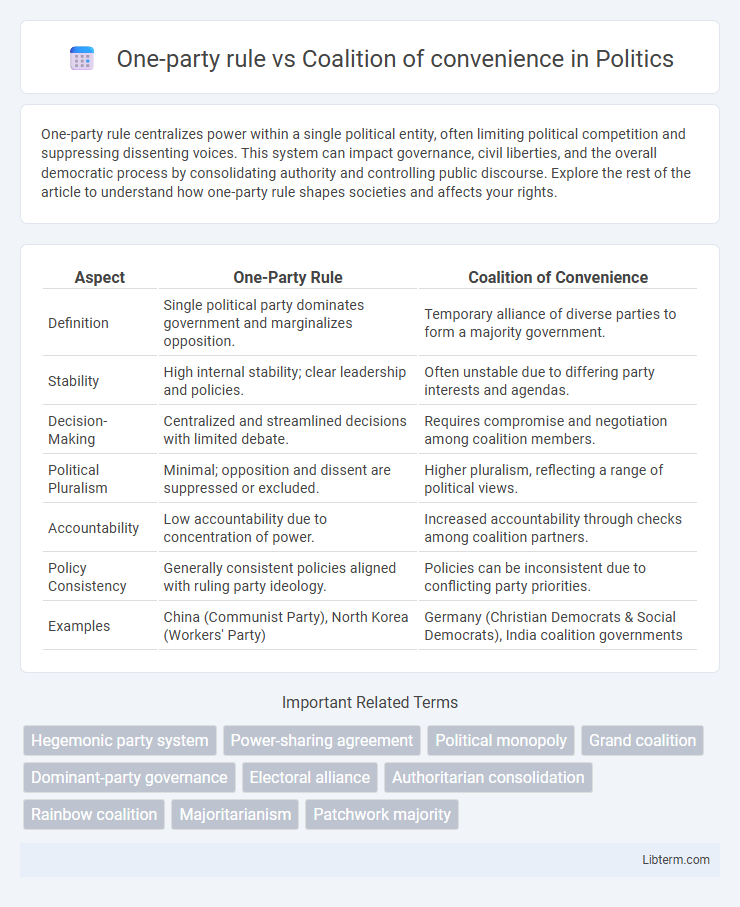One-party rule centralizes power within a single political entity, often limiting political competition and suppressing dissenting voices. This system can impact governance, civil liberties, and the overall democratic process by consolidating authority and controlling public discourse. Explore the rest of the article to understand how one-party rule shapes societies and affects your rights.
Table of Comparison
| Aspect | One-Party Rule | Coalition of Convenience |
|---|---|---|
| Definition | Single political party dominates government and marginalizes opposition. | Temporary alliance of diverse parties to form a majority government. |
| Stability | High internal stability; clear leadership and policies. | Often unstable due to differing party interests and agendas. |
| Decision-Making | Centralized and streamlined decisions with limited debate. | Requires compromise and negotiation among coalition members. |
| Political Pluralism | Minimal; opposition and dissent are suppressed or excluded. | Higher pluralism, reflecting a range of political views. |
| Accountability | Low accountability due to concentration of power. | Increased accountability through checks among coalition partners. |
| Policy Consistency | Generally consistent policies aligned with ruling party ideology. | Policies can be inconsistent due to conflicting party priorities. |
| Examples | China (Communist Party), North Korea (Workers' Party) | Germany (Christian Democrats & Social Democrats), India coalition governments |
Understanding One-Party Rule: Definition and Features
One-party rule denotes a political system where a single party monopolizes power, controlling government functions without opposition or meaningful electoral competition. Key features include centralized authority, restricted political pluralism, and often the suppression of dissent to maintain regime stability. This contrasts with coalitions of convenience, which are temporary alliances formed to achieve specific political goals without long-term ideological unity.
What Is a Coalition of Convenience?
A coalition of convenience is a temporary alliance between political parties or groups formed to achieve a specific goal or maintain power despite differing ideologies. Unlike one-party rule, where a single party dominates without opposition, coalitions of convenience rely on strategic partnerships that may dissolve once objectives are met or conflicts arise. This type of coalition often emerges in parliamentary systems where no party secures a majority, creating an unstable governance structure.
Historical Contexts: One-Party Rule vs Coalitions
One-party rule historically establishes centralized authority, exemplified by regimes like the Soviet Union and Maoist China, where political pluralism is suppressed to maintain uniform policy implementation. Coalitions of convenience emerge in multi-party democracies such as post-war Italy or Israel, where temporary alliances form to achieve legislative majorities despite ideological differences. These coalitions often reflect political compromise and adaptability, contrasting the rigid, hierarchical structures characteristic of one-party states.
Stability and Governance: Which System Delivers?
One-party rule often provides greater political stability by centralizing decision-making and minimizing conflict, leading to more consistent governance. In contrast, a coalition of convenience may face instability due to conflicting interests among parties, which can hinder effective policymaking and prolong negotiations. However, coalitions can enhance representativeness and accountability, potentially delivering governance that reflects a broader spectrum of public interests.
Decision-Making Efficiency: Unified vs Shared Power
One-party rule streamlines decision-making by centralizing authority within a single political entity, enabling swift policy implementation without internal conflict. Coalition of convenience involves shared power among diverse parties, often leading to prolonged negotiations and compromises that can delay or dilute decisions. This shared governance structure may foster broader representation but typically sacrifices efficiency for inclusivity.
Accountability and Transparency Concerns
One-party rule often faces significant accountability and transparency concerns due to the concentration of power and limited opposition oversight, which can lead to unchecked decision-making and corruption. In contrast, coalitions of convenience, while potentially fragmented and unstable, must maintain greater transparency to balance diverse interests and uphold collective responsibility. Both systems encounter challenges, but coalition governments generally encourage more open governance practices to sustain cooperation among varied political actors.
Policy Continuity and Adaptability
One-party rule often ensures strong policy continuity due to centralized decision-making, allowing consistent long-term strategic planning without frequent disruptions. In contrast, a coalition of convenience fosters adaptability by requiring negotiation and compromise among diverse parties, enabling policies to evolve in response to shifting political and social dynamics. However, coalition governance may face challenges in maintaining stable policy direction, as competing interests can slow decision-making and dilute original policy goals.
Representation and Inclusivity in Governance
One-party rule often limits representation by centralizing power within a single political entity, reducing the diversity of voices in governance and potentially marginalizing minority groups. Coalition of convenience fosters inclusivity by bringing together multiple parties with varying ideologies to collaboratively shape policies, enhancing democratic representation and reflecting broader societal interests. However, the stability of coalition governments can be challenged by conflicting agendas, whereas one-party systems may ensure consistent policy implementation but at the cost of pluralism.
Risks: Corruption, Gridlock, and Voter Disillusionment
One-party rule often risks entrenched corruption due to lack of accountability and reduced political competition, while coalitions of convenience may lead to legislative gridlock as diverse interests confront ideological conflicts. Both systems can fuel voter disillusionment: one-party dominance suppresses meaningful political choice, and coalition instability undermines effective governance. These dynamics compromise democratic responsiveness, increasing public cynicism and decreasing electoral participation rates.
Global Examples: Lessons from Past and Present
One-party rule, exemplified by China's Communist Party, often ensures policy continuity and centralized control but risks authoritarian stagnation and limited political pluralism. Coalitions of convenience, as seen in Germany's CDU-SPD alliance, enable pragmatic governance and broader representation yet face instability from ideological compromises and competing interests. Historical experiences in countries like Nigeria demonstrate that shifting from single-party dominance to coalition governments can foster democratic resilience but also expose political fragmentation.
One-party rule Infographic

 libterm.com
libterm.com